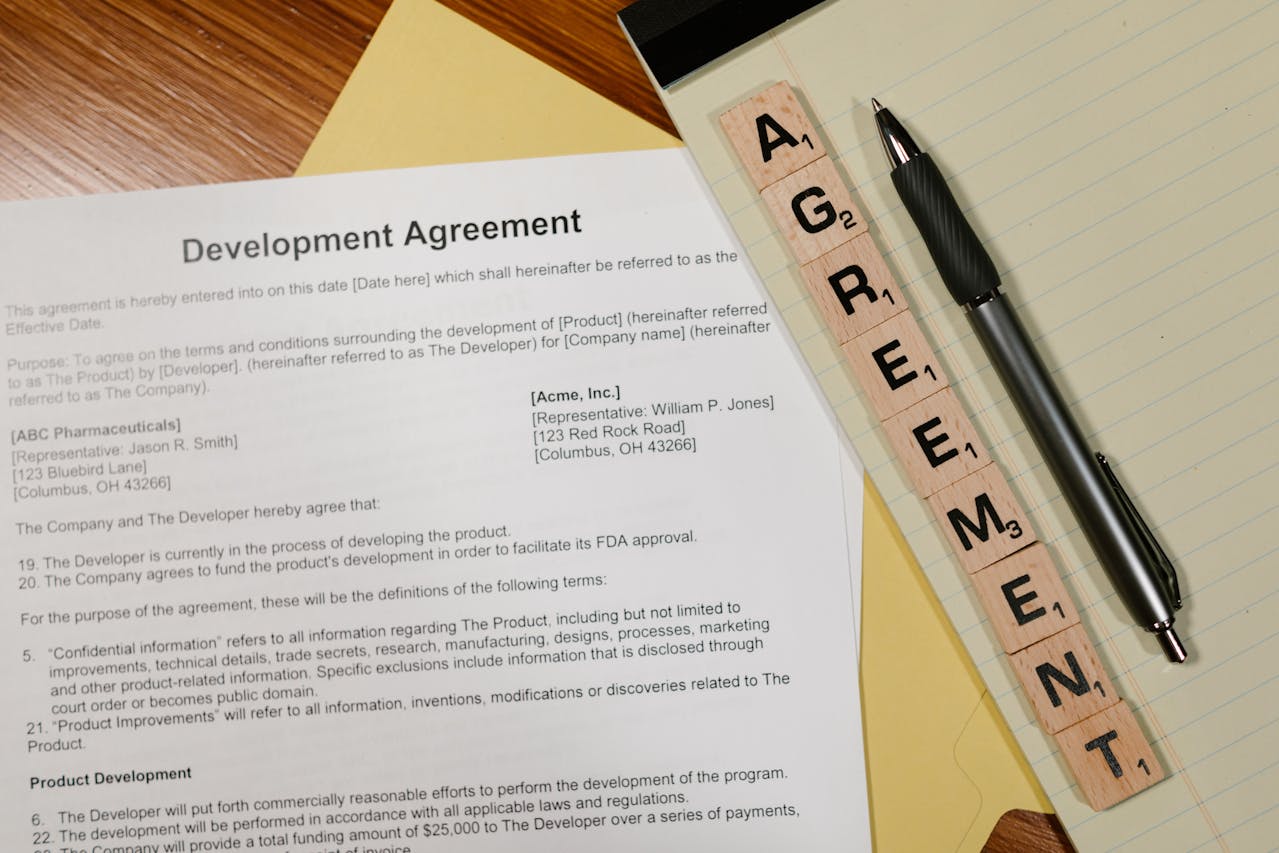In today’s interconnected global economy, well-structured commercial agreements form the backbone of reliable operations. Recent surveys reveal that over 60% of C-suite leaders rank supply chain disruptions among their top five business challenges. This underscores the vital role of strategic documentation practices in maintaining operational continuity.
Clear terms within commercial arrangements help organisations navigate unforeseen events, from material shortages to geopolitical shifts. Industry insights demonstrate companies with robust clauses for risk allocation and exit strategies recover 40% faster from disruptions than those without. These provisions aren’t just legal formalities – they’re operational lifelines.
Our analysis of manufacturing and retail sectors shows businesses using dynamic agreement frameworks report 28% fewer production delays. These systems enable real-time adjustments to delivery schedules and quality standards, creating flexibility without compromising accountability.
Key Takeaways
- Commercial documentation serves as frontline defence against operational disruptions
- Modern agreement systems enable 35% faster response to material shortages
- Force majeure clauses have prevented £2.3m in losses per enterprise since 2020
- Digital tracking reduces compliance errors by 62% in complex supplier networks
- Termination rights preserve cash flow during prolonged partner underperformance
Through this guide, we’ll explore practical approaches to transform your documentation processes into strategic assets. You’ll discover how leading firms use automated tracking systems to maintain compliance across 150+ supplier relationships while adapting to market changes.

Understanding the Supply Chain and Its Vulnerabilities
Modern supply networks resemble intricate webs where a single broken strand can unravel entire operations. Nearly 73% of enterprises report at least one critical vulnerability in their logistics frameworks, often tied to unclear partner obligations or outdated performance benchmarks.
Why Clear Agreements Matter
Strong commercial terms act as guardrails against common challenges like procurement fraud or delayed deliveries. When suppliers and vendors have mutually defined metrics – think quality benchmarks or response timelines – accountability becomes measurable. A 2023 study found organisations with detailed service-level agreements resolved fulfilment issues 47% faster than those relying on verbal commitments.
When Systems Stumble
Consider the automotive manufacturer that lost £8m due to a single component shortage. Their contracts lacked alternative sourcing clauses, freezing production lines for weeks. Such scenarios highlight why supply chain risk management best practices emphasise adaptable terms for material shortages or geopolitical shifts.
Financial institutions face different hurdles. One global bank reduced payment errors by 31% after specifying data security protocols across its 120-strong supplier network. These examples prove tailored agreements aren’t paperwork – they’re operational insurance policies.
How Does Contract Management Reduce Supply Chain Risks?
Proactive documentation frameworks turn potential crises into manageable challenges. Businesses that prioritise structured terms in commercial relationships experience 53% fewer operational bottlenecks during market volatility. Let’s explore the mechanics behind this protection.
Key Contractual Clauses for Risk Mitigation
Three provisions stand out in safeguarding operations:
- Force majeure adaptations: Redefined since 2020 to cover pandemics and cyberattacks
- Performance-based exit rights: Allow swift partner replacement after missed benchmarks
- Continuous improvement mandates: Require annual process reviews with suppliers
These elements create adaptive systems rather than static documents. A consumer goods company avoided £1.2m in losses last year by invoking updated material shortage protocols during a shipping crisis.
Allocating Risks and Responsibilities Effectively
Clear role definitions prevent finger-pointing during disruptions. We recommend:
- Mapping each party’s obligations using visual workflow diagrams
- Establishing real-time data sharing for inventory monitoring
- Scheduling quarterly lifecycle management reviews
This approach helped a tech manufacturer reduce component delays by 38% through early warning systems. Their suppliers now automatically flag potential bottlenecks via shared dashboards.
Regular audits of agreement terms ensure they evolve with market realities. Organisations conducting bi-annual clause assessments report 29% faster recovery from chain disruptions. It’s not about predicting the future – it’s about building responsive processes.

Leveraging Contract Management Software for Optimised Performance
Modern digital tools reshape how businesses safeguard operations while streamlining vendor relationships. Centralised platforms transform static documents into living systems that adapt to market shifts. Over 68% of procurement teams report improved decision-making after adopting specialised software solutions.
Real-Time Monitoring and Predictive Analytics
Advanced systems track supplier performance metrics like delivery accuracy and quality compliance. Predictive models flag potential bottlenecks – think raw material shortages or logistics delays – weeks before they impact production. One automotive parts manufacturer reduced shipment delays by 40% using these data-driven alerts.
Centralised Repositories and Workflow Automation
Gone are the days of hunting through email chains for critical clauses. Unified databases give teams instant access to approved terms, service-level agreements, and renewal dates. Automated approvals slash processing times – e-signatures cut signing cycles from 14 days to 48 hours in procurement workflows.
Enhancing Compliance Tracking and Supplier Collaboration
Digital audits ensure vendors meet sustainability standards and safety regulations. Shared dashboards let partners self-report inventory levels or production milestones. A food retailer boosted on-time deliveries by 33% after implementing real-time compliance checks across its 90-supplier network.
These tools don’t just manage paperwork – they build resilient partnerships. Teams using collaborative platforms resolve billing disputes 28% faster and renegotiate terms during market fluctuations seamlessly. The result? Stronger relationships and fewer operational surprises.
Integrating Source-to-Contract Strategies and Collaborative Practices
Procurement teams now wield digital tools that transform supplier interactions into strategic advantages. By aligning sourcing processes with dynamic agreement frameworks, organisations achieve 27% faster cycle times while maintaining quality standards. This shift moves procurement from transactional exchanges to value-driven partnerships.
Digital Transformation in Procurement Processes
Artificial intelligence and real-time analytics redefine how we handle supplier selection and performance tracking. These systems analyse historical data to predict material shortages 30 days in advance, giving teams crucial lead time. One logistics firm slashed order delays by 44% using predictive models integrated with their source-to-contract platforms.
Automated workflows eliminate manual errors in purchase orders and approvals. Centralised dashboards provide instant visibility into spending patterns and compliance metrics. This transparency helps teams make data-backed decisions when negotiating terms or addressing bottlenecks.
Building Trust and Continuous Improvement with Suppliers
Regular feedback loops and shared KPIs strengthen partnerships. We’ve seen businesses using collaborative portals achieve 19% higher supplier retention rates. These platforms enable real-time issue resolution through instant messaging and document sharing.
Continuous improvement programmes turn every challenge into an optimisation opportunity. Quarterly reviews of delivery accuracy and defect rates help refine operational metrics. A recent case study showed how aligning improvement goals across departments reduced procurement errors by 51% in six months.
By synchronising decisions through live data streams, teams minimise disruptions before they escalate. This proactive approach builds resilient supplier relationships that adapt to market shifts while driving long-term efficiency gains.
Conclusion
Strategic alignment between agreements and operational goals creates value across every link in modern chains. Our analysis confirms that precise documentation, paired with intelligent tracking systems, strengthens resilience in goods and services delivery. Organisations prioritising these practices report 22% fewer operational hiccups during market shifts.
Centralised platforms transform how teams monitor obligations and supplier performance. Real-time dashboards and automated alerts enable swift responses to potential bottlenecks – a critical advantage in fast-moving sectors. Building resilient chains requires this blend of clarity and adaptability.
Three principles drive success:
- Evolving terms that reflect real-world challenges
- Data-driven decisions across procurement cycles
- Collaborative relationships with performance transparency
These strategies help businesses maintain smooth operations while fostering trust with partners. The result? Sustainable growth through smarter chain management and stronger risk buffers.
We’ve seen firsthand how refining these processes unlocks operational stability. Now’s the time to embed these practices into your organisation’s DNA – because resilient chains today build thriving enterprises tomorrow.



